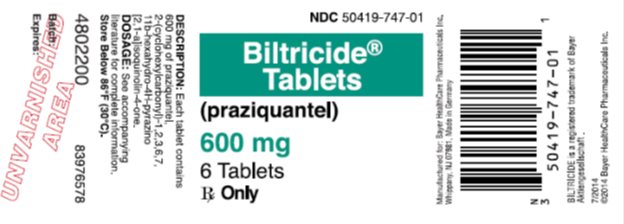Biltricide
What is Biltricide (Praziquantel)?
Approved To Treat
Related Clinical Trials
Summary: Neurocysticercosis is a brain disease due to the larval stage of the pork tapeworm (Taenia solium). The most common symptoms patient experience from infection inside the substance of the brain (parenchymal disease) are seizures and headaches. When the infection is either inside the fluid pockets inside the brain (ventricular disease) or in the space around the brain (subarachnoid disease) patients...
Summary: Urogenital schistosomiasis caused by infection with the blood fluke Schistosoma haematobium is a debilitating disease. The World Health Organization (WHO) has set the goal to eliminate schistosomiasis as a public health problem globally by 2030 and to interrupt transmission in selected areas. Many years of control interventions and mass drug administration have reduced substantially the prevalence...
Summary: The proposed small-scale pilot studies are public health intervention studies implemented through established routine programs and services in the frame of the mass drug administration (MDA) campaigns in Côte d'Ivoire, Kenya and Uganda. In each country two most promising health intervention platforms were selected for pilot distribution of arpraziquantel 150mg (arPZQ). The aim of the small-scale p...
Related Latest Advances
Brand Information
- Schistosomiasis due to all species of schistosoma (for example,
- Clonorchiasis and Opisthorchiasis due to the liver flukes,
- Patients who previously have shown hypersensitivity to praziquantel or any of the excipients in Biltricide.
- Patients with ocular cysticercosis; since parasite destruction within the eye that occurs because of hypersensitivity reaction to the dead parasite after treatment may cause irreversible lesions, ocular cysticercosis must not be treated with Biltricide.
- Patients taking strong Cytochrome P450 3A enzyme (CYP3A) inducers, such as rifampin,
- Clinical Deterioration
- Central Nervous System (CNS) Effects
- Potential Lack of Efficacy During the Acute Phase of Schistosomiasis
- Cardiac Arrhythmias
- Hepatic Impairment in Hepatosplenic Schistosomiasis Patients
- Concomitant Administration with Strong Cytochrome P450 Inducers

- Advise patients to take Biltricide during meals as directed
- Advise patients not to chew tablets and to take them with water
- Advise patients that tablets may be crushed or disintegrated and mixed with semi-solid food or liquid or disintegrated to prevent choking in children under 6 years of age. Crushed or disintegrated tablets should be used within 1 hour of mixing
- Advise patients not to take Biltricide if they are allergic to Biltricide or any of its components
- Advise patients not to take Biltricide if they are taking rifampin
- Advise patients not to take Biltricide if they are taking efavirenz
- Advise patients that the use of praziquantel can be associated with clinical deterioration during the acute phase of schistosomiasis
- Advise patients that Biltricide should not be used if they have epilepsy of or other CNS effects
- Advise patients to report any cardiac irregularities to their healthcare provider
- Advise patients not to drive a car and not to operate machinery on the day of Biltricide treatment and the following day.

